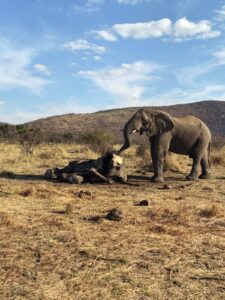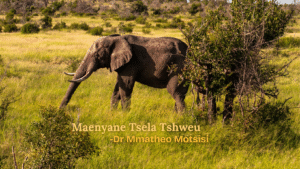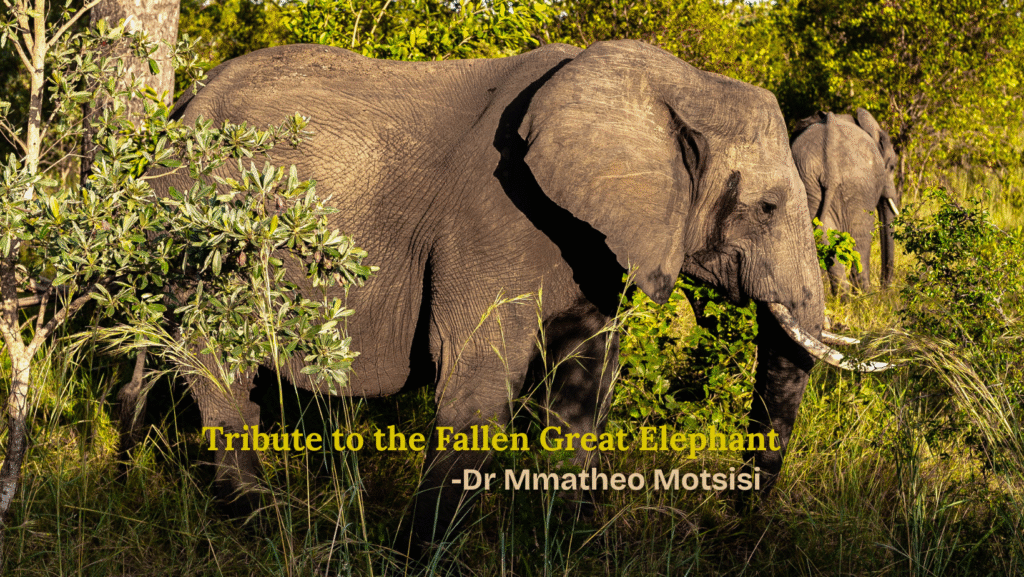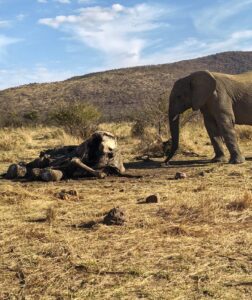Elephant🐘 Mourning: A Witness to Memory
In a world where the sacredness of life has lost its meaning, I was called to pause and bear witness to the Great Elephant mourning its kin. This weekend, as we celebrated Women’s Day, I stood very small before something vast at the Pilanesberg National Game Reserve. The scene etched itself into my body: a lone Elephant keeping vigil beside the stillness of another, a slow choreography of touch and waiting. The light had thinned; the air carried that hush belonging only to places where nature chooses to lean in and listen.

Totems and Thresholds
I have long carried the Elephant and the Crocodile as my totems—guardians at the thresholds of memory and change. They have walked with me through decisions and dreams. Still, nothing in my reverence or practice prepared me for the weight of that moment. I felt, with a physical ache, the interior life of that great animal: a grief that was not noise but gravity. It tugged at the parts of me schooled in reason and at the parts that make room for mystery.
What the Field Tells Us
Ethologists and field researchers have documented Elephants’ responses to death for decades: standing vigil, touching the bones or body with trunks, lingering for hours or days, and sometimes returning to a place where a herd member died. These behaviours suggest recognition and an emotional life complex enough to include mourning. Yet scientific description alone does not reach the full felt truth of being there. Facts shape the edges of experience; they do not supply its center.
Watching the Elephant brush its trunk along the still flank and then along the exposed bone, I noticed a tenderness in the motion—a repeated, exact gesture that felt like a prayer. It was not performative. It was deliberate and slow, an enactment of attention. In that attention I felt mirrored my human ache of loss and the urgent need to honour what has been.
Mourning as Communication
The 🐘Elephant’s ritual—if ritual is the word—showed me that grief is not a collapse but a form of communication. It is a language that spans species, an expression of the bonds that knit the living into community. The trunk’s light pressure, the pause between movements, the steady posture: each small act seemed to carry meaning. Whether interpreted through ethology or spirit, the message was the same: this life mattered.
A Field Opens
Spiritually, the encounter opened like a field. My chest loosened; a voice, ancestral and intimate, whispered of cycles and acknowledgement. The Elephant’s mourning read to me as invocation: that Life—even as it departs—is still fully held. In its pauses and touches I saw a model of how to remember: reverently, bodily, and without haste.
I reflected on my kin who have transitioned into the spiritual realm and on the importance of honouring life’s gift across domains. In my work with people—helping them carry pain, witnessing their grief—I have long understood the power of presence. Here in the reserve, that understanding was deepened and simplified: to witness is itself a healing act.
Teaching Through Sorrow
There was another layer: the recognition that in sorrow there is teaching. The Elephant stands both as Mourner and as Teacher. Its dignity in grief taught me the restraint of patience and the kind of compassion that shelters pain instead of rushing to fix it. The landscape became a classroom where the simplest gestures contained the most rigorous lessons.
After the Vigil
I left the place altered. For days afterward, ordinary sights—a fallen bird, a weathered tree, the lined face of an elder—carried an echo of that vigil. Mourning is not an event confined to a single moment; it is an ongoing frontier of the heart. Seeing loss practiced by an animal so ancient and sentient reframes the human approach to sorrow: grief is not a sign of weakness but proof of kinship.
If there is a final lesson I carried home, it is this: to stand with someone—in silence, in touch, in steady presence—is to enact a sacrament. To touch what has been lost with gentleness and to make space for the story to be honored keeps memory alive. In making room for sorrow, we enlarge life itself.

🐘 The Great Elephant Mourning Its Kin
1. Emotional Advocacy:
Grief is not just human. When an Elephant mourns, it reminds us: Every life lost to poaching, habitat loss, or neglect is felt deeply in the herd—and should be felt by us all.
2. Conservation Call-to-Action:
This is not just mourning. It’s a warning. Protecting Elephants means protecting the Emotional fabric of the Wild.
3. Ethical Reflection:
The Great Elephant bows its Head—not in Defeat, but in Remembrance. Let us not be the reason its kin vanish.
4. Legacy & Responsibility:
Elephants mourn their dead. What will we do for the living? Conservation is not charity—it’s justice.
5. Global Solidarity:
In the quiet sorrow of an Elephant, the world should hear a roar: Protect what remains, before silence becomes Permanent.


